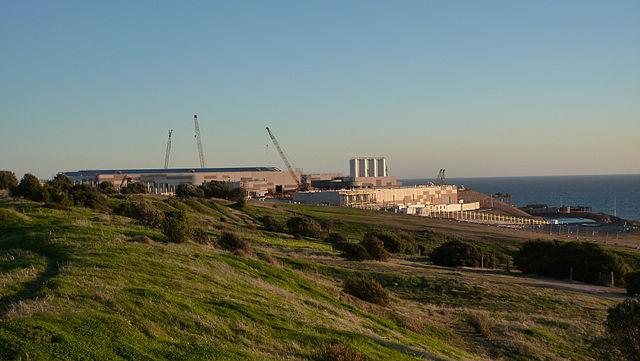The world’s freshwater supply is in crisis. 97.5% of Earth’s water is undrinkable salt water. That leaves 2.5% of all water on Earth as freshwater, but 70% of that water is used for agriculture. That leaves less than 0.75% of Earth’s water for human consumption, right? Wrong. For every 100 drops of rain, only 36 are ‘blue water’ – water that enters our freshwater sources. So really, just 0.27% of the world’s water can be domestically used by humans. By 2050, food production is expected to increase by 60%, and accordingly, water demand is expected to rise by 55% between 2000 and 2050.
Compounding the issue is climate change. Yes, the same change that is causing more intense rainstorms is actually causing a water shortage. The reality is that soil is becoming drier, which, along with warming temperatures, leads to drought. Hotter temperatures cause more water to evaporate from the soil. Thus, the soil has to absorb more water when it rains, leaving less running water for humans to use. This means that despite increased rainfall, floods have actually decreased in many regions because the soil sucks up the excess water, making it impossible to collect as freshwater. Due to this, less water runs off into the world’s rivers. Furthermore, drying soil necessitates more water for agriculture, which exacerbates the already shrinking water supply.
Water is supposed to be a renewable resource, but only if it is used responsibly. Unfortunately, water is not being used responsibly. Earth will never run out of water, but it may very well run out of usable water. Each year, 2.1 trillion gallons of water are lost in the United States due to leaking pipes. That’s enough to supply 19 million households with water for a year, just in the U.S. But leaky pipes cannot account for the 117 trillion gallons of water used by the U.S. each year. Of that figure, 41% is used for thermoelectric power generation, 37% for irrigation, and just 3% for consumption. The real culprit of the world’s shockingly high water use is irrigated agriculture, which is twice as productive as the rain-fed agriculture of centuries past. Irrigation allows for increased production and crop diversification to feed a growing population, but at the cost of the water required to irrigate fields, apply pesticides and fertilizers, and defrost crops. At the same time, water is being pumped at higher rates than it can be naturally replenished. For example, the largest underground water source in the U.S., the Ogallala Aquifer, is being pumped at rates thousands of times more quickly than it can be replenished by rainfall. The final main role of water is in thermoelectric power. Thermoelectric generators take a temperature difference between two metals and create electricity via the movement of electrons. Water is often used in this process to cool one end of the metal to create a temperature difference. Science Daily notes that if the renewable energy situation does not improve by 2040, there will not be enough available freshwater to meet the world’s energy needs.
If humans can only drink 0.27% of the world’s water, what if we could drink the other 99%? This is the promise made by saltwater desalination, which removes salt from seawater to make it drinkable. Sea levels are rising worldwide and cities are being attacked by waves. According to Live Science, Jakarta, Dhaka, Lagos, and Bangkok could be underwater by 2100. Closer to home, parts of Miami, Virginia Beach, New York City, and Boston – and all of New Orleans, could be underwater by the turn of the century. It makes sense to remove that excess water from the ocean that floods our cities and use it as drinking water.
The modern process of saltwater desalination utilizes reverse osmosis. When applied to desalination, the method sends water first through a filter to remove sediment and chlorine. Next, water passes through a semipermeable membrane to filter out dissolved solids, relying on the fact that water molecules are smaller than the pollutants in the water. Finally, the water goes through another filter to remove any remaining undrinkable substances. The main issue with reverse osmosis is that to maintain the incredibly high water pressure required to filter out pollutants, energy-intensive pumps and other equipment are required.
Since its invention, energy usage has been the main prohibiting factor behind the wide adoption of desalination. But in 2021, two Purdue engineers developed a more energy-efficient system based on Professor David Warsinger’s concept of batch reverse osmosis. The original system takes in a set amount of water at once, filters it, discharges it, and then loads the next quantity of water. This method lessened energy produced by pumps but increased processing time for desalinated water. Additionally, batch reverse osmosis wasn’t much more energy-efficient either, because machines had to keep running between desalination batches. As such, the system was not widely adopted. But soon it may be. The newest rendition, “double-acting batch reverse osmosis,” improves the efficiency by using a piston system that allows the next batch of water to be loaded into a tank so it can go into the processing loop immediately after the previous batch is complete. Purdue’s researchers found double-acting batch reverse osmosis to be the most energy-efficient method of desalination. It is actually 31% more efficient compared to standard reverse osmosis, which itself would only account for 4% of the country’s energy usage if all of the U.S.’s water was desalinated.
Another fundamental obstacle in the desalination process is that because reverse osmosis filters out salt and harmful chemicals, the residue – or brine – of the salt and chemicals must be disposed of somehow. Reverse osmosis outputs 58% brine and 42% usable water. Currently, brine is either dumped into the ocean, spread on land, or put in the ground. The issue is that brine is toxic to marine life. Aside from brine from thermal desalination (not reverse osmosis) being hotter than ocean water, brine often contains cleaning chemicals and heavy metals from the pipes it passes through. The amount of chemicals in brine is often very small, depending on the desalination method, but brine – which is almost all salt – removes oxygen from the water, suffocating certain species in coastal areas. Making seawater saltier also makes it more difficult to desalinate the water in the future. The main way processing plants combat this issue is by dumping brine into bodies of water with strong currents that can disperse the brine to the middle of the ocean, rather than allowing it to gather near the coast. However, this is only feasible when a desalination plant is located nearby an ocean with strong currents. This is not the case with the Arabian Gulf, for example, where many plants are located. Some plants have attempted to mitigate the brine problem by pumping the brine through multiple outlets, spreading it out in the water. Others use high-pressure pumps to push the brine further into the sea. These two methods have the least destructive impact of the many methods used for brine disposal, but they still cause minor issues with aquatic life near the outlet area. Still, that’s a small price to pay to get clean water to those who need it, especially when the impacts of desalination can be mitigated to a satisfactory level.
If brine wasn’t enough of a challenge, removing boron from desalinated water has proven difficult. Excess boron in water can cause plants to die, and over five grams of born intake per day can cause fatal conditions in humans. In seawater, boron concentration is 8-11 times as high as the World Health Organization’s (WHO) recommended maximum boron levels. Most reverse osmosis membranes remove 73-90% of boron in water, while specialized filters can remove 95%. However, in warmer temperatures, where many plants are located, the boron concentration can be twice the WHO’s maximum after reverse osmosis. The need for boron removal causes plants to implement more filters, specialized filters, and methods to increase pH (which makes it easier to remove boron). LG developed a specialized membrane that removes nearly 100% of boron, but these methods are often cost-prohibitive. Thus, desalination is not something that can be fully implemented overnight; it will involve years of infrastructure development and investment.
The most simple issue faced by proponents of desalination is that extracting water from the ocean directly kills marine life. When desalination plants pump seawater into their facilities – a process called entrainment – tiny organisms like plankton, fish eggs, and larvae are killed on the journey. However, according to marine biologist Daniel Cartamil, entrainment actually only accounts for 1-2% of plankton deaths in areas near desalination plants. Because desalination pumping doesn’t affect most marine species (which are too big to fit through the pipes), its impact on aquatic ecosystems is generally minimal.
Desalination is not a problem; it’s a solution. As the planet warms and glaciers melt, more saltwater is being introduced every day while more freshwater is being depleted by droughts. The benefits of salt water desalination as a supplement to traditional water collection methods outweigh its detrimental effects.































